key Alfa Romeo GT 2006 Owner handbook (in English)
[x] Cancel search | Manufacturer: ALFA ROMEO, Model Year: 2006, Model line: GT, Model: Alfa Romeo GT 2006Pages: 307, PDF Size: 6.05 MB
Page 17 of 307
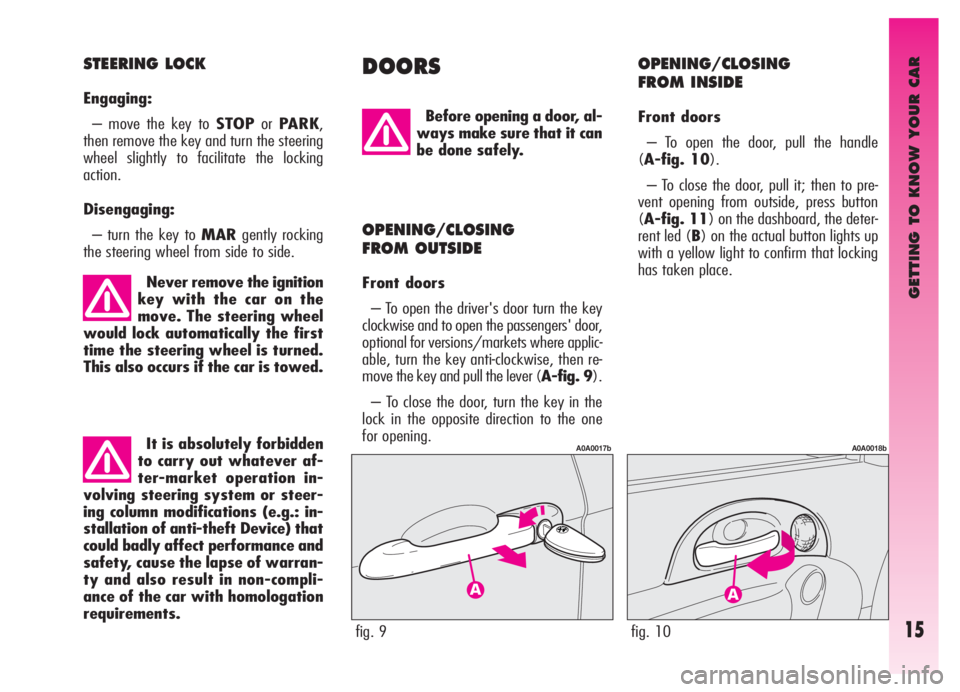
It is absolutely forbidden
to carry out whatever af-
ter-market operation in-
volving steering system or steer-
ing column modifications (e.g.: in-
stallation of anti-theft Device) that
could badly affect performance and
safety, cause the lapse of warran-
ty and also result in non-compli-
ance of the car with homologation
requirements.
GETTING TO KNOW YOUR CAR
15
STEERING LOCK
Engaging:
– move the key to STOPorPARK,
then remove the key and turn the steering
wheel slightly to facilitate the locking
action.
Disengaging:
– turn the key to MARgently rocking
the steering wheel from side to side.
Never remove the ignition
key with the car on the
move. The steering wheel
would lock automatically the first
time the steering wheel is turned.
This also occurs if the car is towed.
DOORS
Before opening a door, al-
ways make sure that it can
be done safely.
OPENING/CLOSING
FROM OUTSIDE
Front doors
– To open the driver's door turn the key
clockwise and to open the passengers' door,
optional for versions/markets where applic-
able, turn the key anti-clockwise, then re-
move the key and pull the lever (A-fig. 9).
– To close the door, turn the key in the
lock in the opposite direction to the one
for opening.
fig. 9
A0A0017b
fig. 10
A0A0018b
OPENING/CLOSING
FROM INSIDE
Front doors
– To open the door, pull the handle
(A-fig. 10).
– To close the door, pull it; then to pre-
vent opening from outside, press button
(A-fig. 11) on the dashboard, the deter-
rent led (B) on the actual button lights up
with a yellow light to confirm that locking
has taken place.
Page 25 of 307

GETTING TO KNOW YOUR CAR
23
REAR-VIEW MIRROR
ADJUSTMENT
INNER
The mirror, fitted with a safety device
that causes it to be released in the event
of a violent crash, can be moved using the
lever (A-fig. 28) to two different posi-
tions, normal or antiglare.
fig. 28
A0A0039b
Folding(fig. 30)
– In the event of need (for example
when the mirror causes difficulty in narrow
spaces) it is possible to fold the mirror
moving it from position (A) to position
(B).
fig. 30
A0A0041b
When driving the mirrors
should always be in posi-
tion (A).
As the driver’s wing mir-
ror is curved, it may slight-
ly alter the perception of
distance.
OUTER
Electric adjustment (fig. 29)
– use the switch (A) to select the mir-
ror required (right or left);
– pressing the button (B) in one of the
four directions, move the mirror selected
previously;
– position the switch (A) in the inter-
mediate locking position.
IMPORTANTAdjustment is possible
only with the ignition key at MAR.
fig. 29
A0A0040b
Page 26 of 307
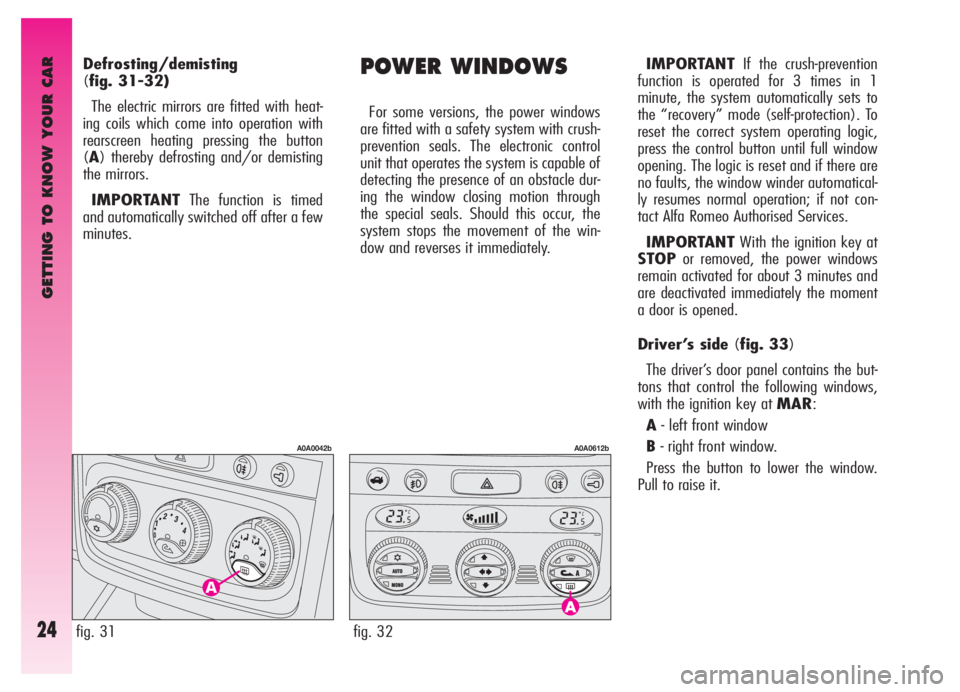
GETTING TO KNOW YOUR CAR
24
POWER WINDOWS
For some versions, the power windows
are fitted with a safety system with crush-
prevention seals. The electronic control
unit that operates the system is capable of
detecting the presence of an obstacle dur-
ing the window closing motion through
the special seals. Should this occur, the
system stops the movement of the win-
dow and reverses it immediately.IMPORTANTIf the crush-prevention
function is operated for 3 times in 1
minute, the system automatically sets to
the “recovery” mode (self-protection). To
reset the correct system operating logic,
press the control button until full window
opening. The logic is reset and if there are
no faults, the window winder automatical-
ly resumes normal operation; if not con-
tact Alfa Romeo Authorised Services.
IMPORTANTWith the ignition key at
STOPor removed, the power windows
remain activated for about 3 minutes and
are deactivated immediately the moment
a door is opened.
Driver’s side (fig. 33)
The driver’s door panel contains the but-
tons that control the following windows,
with the ignition key at MAR:
A- left front window
B- right front window.
Press the button to lower the window.
Pull to raise it. Defrosting/demisting
(fig. 31-32)
The electric mirrors are fitted with heat-
ing coils which come into operation with
rearscreen heating pressing the button
(A) thereby defrosting and/or demisting
the mirrors.
IMPORTANTThe function is timed
and automatically switched off after a few
minutes.
fig. 32
A0A0612b
fig. 31
A0A0042b
Page 27 of 307

GETTING TO KNOW YOUR CAR
25fig. 33
A0A0043b
fig. 34
A0A0044b
IMPORTANTThe driver’s power win-
dow is fitted with the “continuous auto-
matic operation” device for both lowering
and raising the window. A brief press on
the upper or lower part of the button will
cause it to move and continue automati-
cally: the window stops in the required
position by pressing either the upper or
lower part of the button again.
Passenger’s side (fig. 34)
The button (A) controls the passenger’s
side window.
Button and window operation is the
same as that described for the driver's
side.Do not keep the button
pressed when the window
is completely raised or
lowered.
IMPORTANTFor versions/markets
where applicable, if the car is fitted with the
safety system with crush-prevention seals,
after locking the doors, keeping the remote
control button pressed for about 2 seconds,
causes automatic closing of the windows.
The remote control button should be pressed
until the windows have completed their
stroke; releasing the button sooner, the win-
dows stop in the position they are in at that
moment.
On all versions, after unlocking the doors,
keeping the remote control button pressed
for about 2 seconds, the windows and sun-
roof (if present) are opened.Improper use of power
windows can be danger-
ous. Before and during use,
always make sure that the pas-
sengers are not exposed to the risk
of harm either directly by the mov-
ing windows or by personal objects
drawn or knocked by them.
When leaving the car, al-
ways remove the ignition
key to prevent the power
windows from being operated in-
advertently, and harming anyone
left on board.
Page 34 of 307
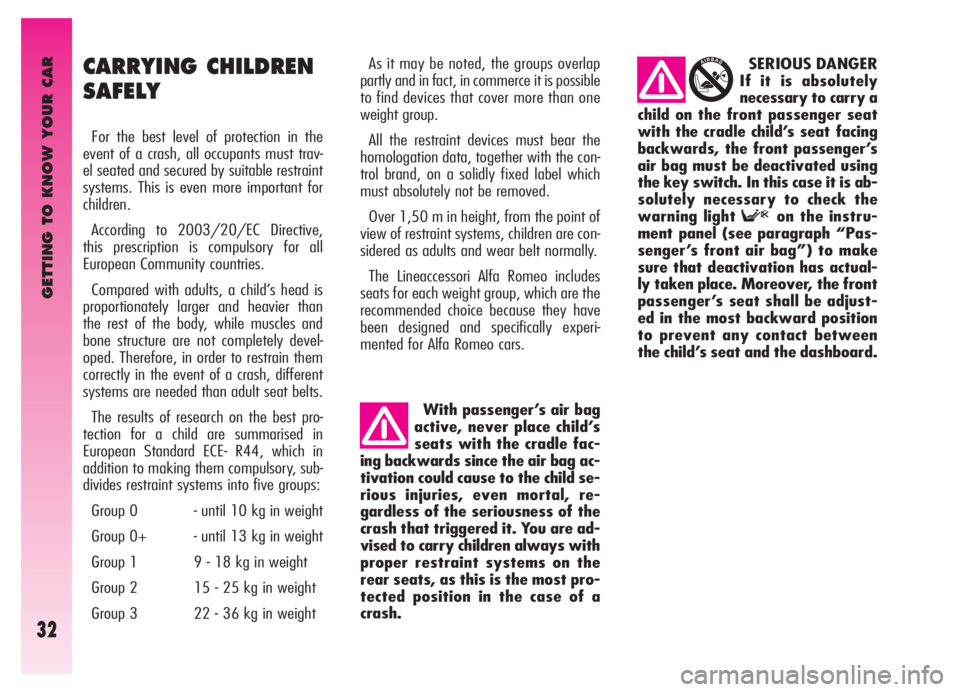
GETTING TO KNOW YOUR CAR
32
CARRYING CHILDREN
SAFELY
For the best level of protection in the
event of a crash, all occupants must trav-
el seated and secured by suitable restraint
systems. This is even more important for
children.
According to 2003/20/EC Directive,
this prescription is compulsory for all
European Community countries.
Compared with adults, a child’s head is
proportionately larger and heavier than
the rest of the body, while muscles and
bone structure are not completely devel-
oped. Therefore, in order to restrain them
correctly in the event of a crash, different
systems are needed than adult seat belts.
The results of research on the best pro-
tection for a child are summarised in
European Standard ECE- R44, which in
addition to making them compulsory, sub-
divides restraint systems into five groups:
Group 0 - until 10 kg in weight
Group 0+ - until 13 kg in weight
Group 1 9 - 18 kg in weight
Group 2 15 - 25 kg in weight
Group 3 22 - 36 kg in weightAs it may be noted, the groups overlap
partly and in fact, in commerce it is possible
to find devices that cover more than one
weight group.
All the restraint devices must bear the
homologation data, together with the con-
trol brand, on a solidly fixed label which
must absolutely not be removed.
Over 1,50 m in height, from the point of
view of restraint systems, children are con-
sidered as adults and wear belt normally.
The Lineaccessori Alfa Romeo includes
seats for each weight group, which are the
recommended choice because they have
been designed and specifically experi-
mented for Alfa Romeo cars.
With passenger’s air bag
active, never place child’s
seats with the cradle fac-
ing backwards since the air bag ac-
tivation could cause to the child se-
rious injuries, even mortal, re-
gardless of the seriousness of the
crash that triggered it. You are ad-
vised to carry children always with
proper restraint systems on the
rear seats, as this is the most pro-
tected position in the case of a
crash.SERIOUS DANGER
If it is absolutely
necessary to carry a
child on the front passenger seat
with the cradle child’s seat facing
backwards, the front passenger’s
air bag must be deactivated using
the key switch. In this case it is ab-
solutely necessary to check the
warning light Fon the instru-
ment panel (see paragraph “Pas-
senger’s front air bag”) to make
sure that deactivation has actual-
ly taken place. Moreover, the front
passenger’s seat shall be adjust-
ed in the most backward position
to prevent any contact between
the child’s seat and the dashboard.
Page 37 of 307

GETTING TO KNOW YOUR CAR
35
PASSENGER SEAT COMPLIANCE WITH REGULATIONS ON CHILD’S SEAT USE
The car omplies with the new EC Directive 2000/3 regulating child’s seat assembling on the different car seats according to the follow-
ing table:
Key:
U= suitable for child restraint systems of the “Universal category”, according to European Standard ECE-R44 for the specified “Group”.
Group
Group 0, 0+
Group 1
Group 2
Group 3
Range of weight
until 13 kg
9-18 kg
15-25 kg
22-36 kgFront
passenger
U
U
U
URear
passengers
U
U
U
UCentral
passenger
U
U
U
U
Page 42 of 307
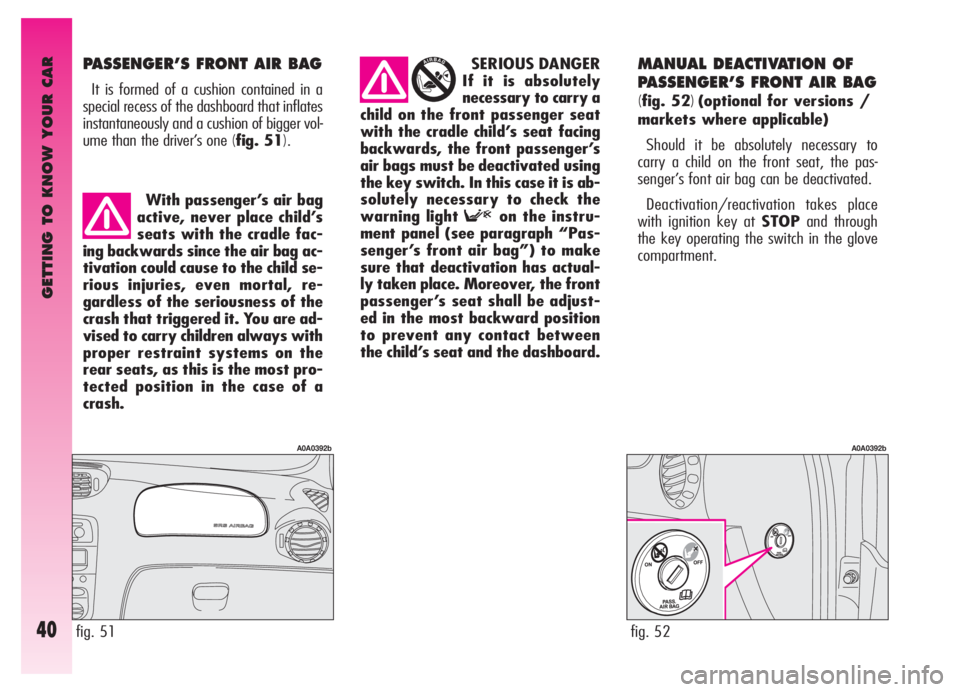
GETTING TO KNOW YOUR CAR
40
PASSENGER’S FRONT AIR BAG
It is formed of a cushion contained in a
special recess of the dashboard that inflates
instantaneously and a cushion of bigger vol-
ume than the driver’s one
(fig. 51).
MANUAL DEACTIVATION OF
PASSENGER’S FRONT AIR BAG
(
fig. 52)(optional for versions /
markets where applicable)
Should it be absolutely necessary to
carry a child on the front seat, the pas-
senger’s font air bag can be deactivated.
Deactivation/reactivation takes place
with ignition key at STOPand through
the key operating the switch in the glove
compartment. SERIOUS DANGER
If it is absolutely
necessary to carry a
child on the front passenger seat
with the cradle child’s seat facing
backwards, the front passenger’s
air bags must be deactivated using
the key switch. In this case it is ab-
solutely necessary to check the
warning light Fon the instru-
ment panel (see paragraph “Pas-
senger’s front air bag”) to make
sure that deactivation has actual-
ly taken place. Moreover, the front
passenger’s seat shall be adjust-
ed in the most backward position
to prevent any contact between
the child’s seat and the dashboard.
fig. 51
A0A0392b
fig. 52
A0A0392b
With passenger’s air bag
active, never place child’s
seats with the cradle fac-
ing backwards since the air bag ac-
tivation could cause to the child se-
rious injuries, even mortal, re-
gardless of the seriousness of the
crash that triggered it. You are ad-
vised to carry children always with
proper restraint systems on the
rear seats, as this is the most pro-
tected position in the case of a
crash.
Page 43 of 307
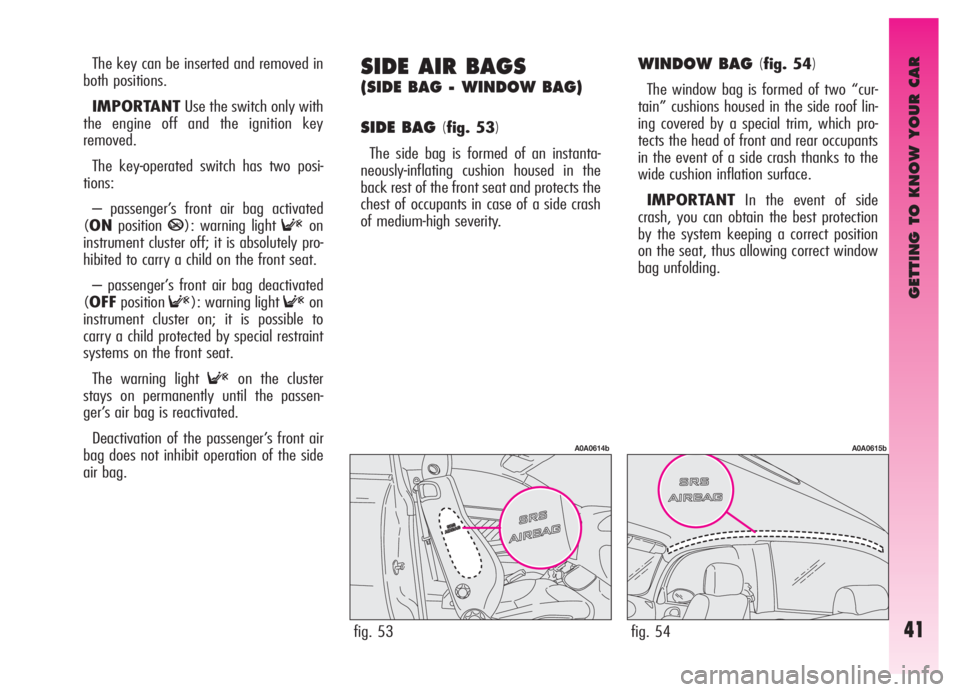
GETTING TO KNOW YOUR CAR
41
The key can be inserted and removed in
both positions.
IMPORTANTUse the switch only with
the engine off and the ignition key
removed.
The key-operated switch has two posi-
tions:
– passenger’s front air bag activated
(ONpositionP): warning light
Fon
instrument cluster off; it is absolutely pro-
hibited to carry a child on the front seat.
– passenger’s front air bag deactivated
(OFFposition
F): warning light Fon
instrument cluster on; it is possible to
carry a child protected by special restraint
systems on the front seat.
The warning light
Fon the cluster
stays on permanently until the passen-
ger’s air bag is reactivated.
Deactivation of the passenger’s front air
bag does not inhibit operation of the side
air bag.
SIDE AIR BAGS
(SIDE BAG - WINDOW BAG)
SIDE BAG (
fig. 53)
The side bag is formed of an instanta-
neously-inflating cushion housed in the
back rest of the front seat and protects the
chest of occupants in case of a side crash
of medium-high severity.
WINDOW BAG (fig. 54)
The window bag is formed of two “cur-
tain” cushions housed in the side roof lin-
ing covered by a special trim, which pro-
tects the head of front and rear occupants
in the event of a side crash thanks to the
wide cushion inflation surface.
IMPORTANTIn the event of side
crash, you can obtain the best protection
by the system keeping a correct position
on the seat, thus allowing correct window
bag unfolding.
fig. 53
A0A0614b
fig. 54
A0A0615b
Page 45 of 307
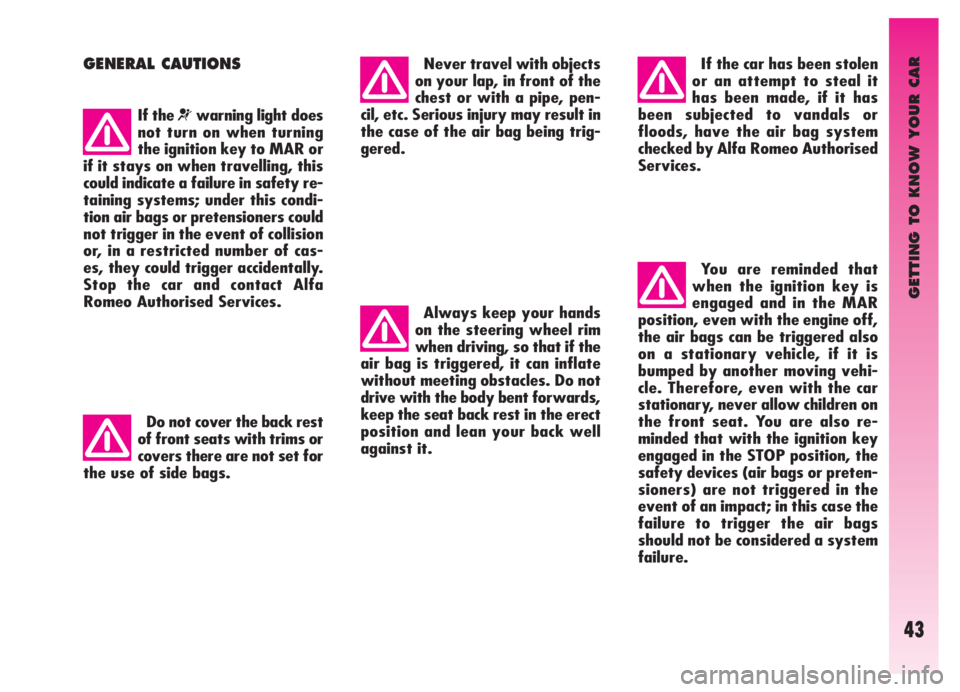
GETTING TO KNOW YOUR CAR
43
GENERAL CAUTIONS
If the ¬warning light does
not turn on when turning
the ignition key to MAR or
if it stays on when travelling, this
could indicate a failure in safety re-
taining systems; under this condi-
tion air bags or pretensioners could
not trigger in the event of collision
or, in a restricted number of cas-
es, they could trigger accidentally.
Stop the car and contact Alfa
Romeo Authorised Services.
Do not cover the back rest
of front seats with trims or
covers there are not set for
the use of side bags.Never travel with objects
on your lap, in front of the
chest or with a pipe, pen-
cil, etc. Serious injury may result in
the case of the air bag being trig-
gered.
Always keep your hands
on the steering wheel rim
when driving, so that if the
air bag is triggered, it can inflate
without meeting obstacles. Do not
drive with the body bent forwards,
keep the seat back rest in the erect
position and lean your back well
against it.
If the car has been stolen
or an attempt to steal it
has been made, if it has
been subjected to vandals or
floods, have the air bag system
checked by Alfa Romeo Authorised
Services.
You are reminded that
when the ignition key is
engaged and in the MAR
position, even with the engine off,
the air bags can be triggered also
on a stationary vehicle, if it is
bumped by another moving vehi-
cle. Therefore, even with the car
stationary, never allow children on
the front seat. You are also re-
minded that with the ignition key
engaged in the STOP position, the
safety devices (air bags or preten-
sioners) are not triggered in the
event of an impact; in this case the
failure to trigger the air bags
should not be considered a system
failure.
Page 46 of 307
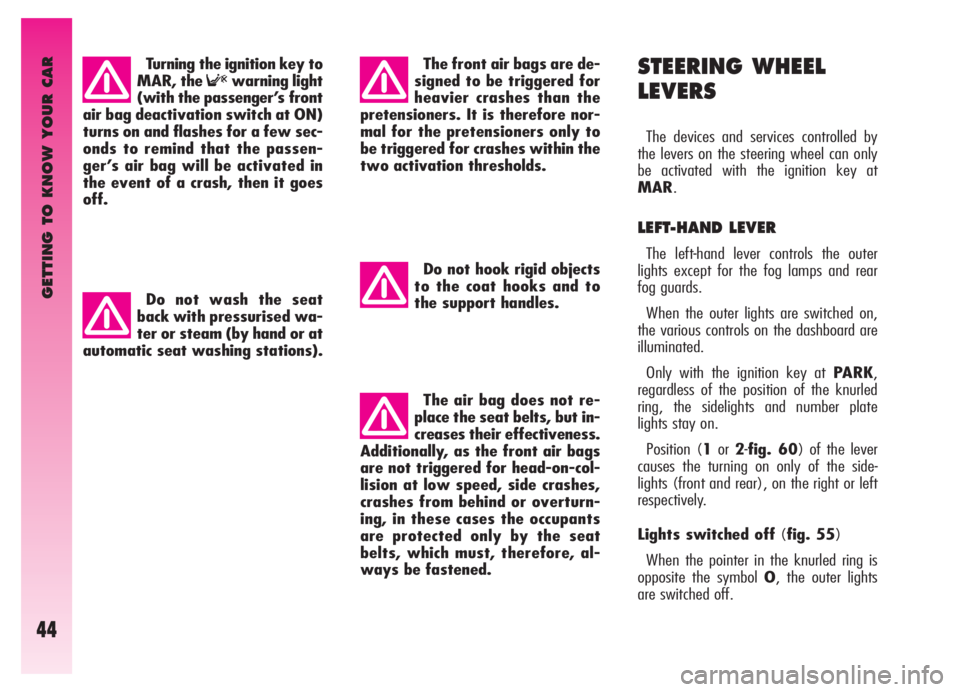
GETTING TO KNOW YOUR CAR
44
STEERING WHEEL
LEVERS
The devices and services controlled by
the levers on the steering wheel can only
be activated with the ignition key at
MAR.
LEFT-HAND LEVER
The left-hand lever controls the outer
lights except for the fog lamps and rear
fog guards.
When the outer lights are switched on,
the various controls on the dashboard are
illuminated.
Only with the ignition key at PARK,
regardless of the position of the knurled
ring, the sidelights and number plate
lights stay on.
Position (1or2-fig. 60) of the lever
causes the turning on only of the side-
lights (front and rear), on the right or left
respectively.
Lights switched off(fig. 55)
When the pointer in the knurled ring is
opposite the symbol O, the outer lights
are switched off. Turning the ignition key to
MAR, the
Fwarning light
(with the passenger’s front
air bag deactivation switch at ON)
turns on and flashes for a few sec-
onds to remind that the passen-
ger’s air bag will be activated in
the event of a crash, then it goes
off.The front air bags are de-
signed to be triggered for
heavier crashes than the
pretensioners. It is therefore nor-
mal for the pretensioners only to
be triggered for crashes within the
two activation thresholds.
Do not hook rigid objects
to the coat hooks and to
the support handles.
The air bag does not re-
place the seat belts, but in-
creases their effectiveness.
Additionally, as the front air bags
are not triggered for head-on-col-
lision at low speed, side crashes,
crashes from behind or overturn-
ing, in these cases the occupants
are protected only by the seat
belts, which must, therefore, al-
ways be fastened. Do not wash the seat
back with pressurised wa-
ter or steam (by hand or at
automatic seat washing stations).